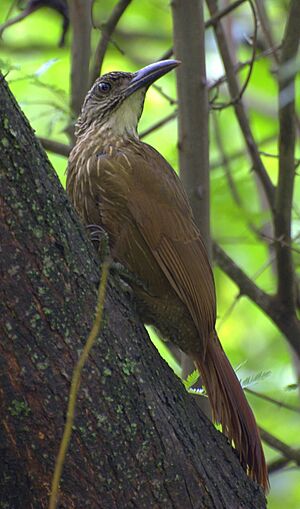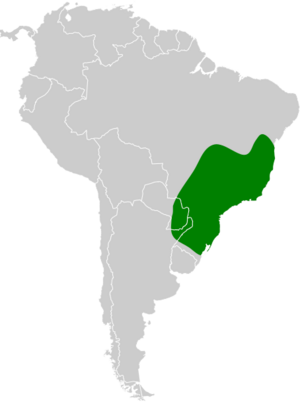White-throated woodcreeper facts for kids
Quick facts for kids White-throated woodcreeper |
|
|---|---|
 |
|
| Conservation status | |
| Scientific classification | |
| Genus: |
Xiphocolaptes
|
| Species: |
albicollis
|
 |
|
The white-throated woodcreeper (Xiphocolaptes albicollis) is a fascinating bird. It lives in the forests of South America. You can find it in countries like Brazil, Argentina, and Paraguay. This bird is famous for its unique way of climbing trees. It uses its strong claws and tail feathers to move up tree trunks. It is part of a bird group called the ovenbird family.
Contents
About the White-throated Woodcreeper
The white-throated woodcreeper is one of the biggest birds in its group. It has a strong body and a tail that is not very long. Its bill is long and curves downwards, which helps it find food. This bird is about 27.5 to 33 centimeters (11 to 13 inches) long. It weighs between 110 and 130 grams (3.9 to 4.6 ounces). Male and female woodcreepers look very similar.
What It Looks Like
This bird has a dark face with a light stripe above its eye. It also has a light stripe near its beak. There is a dark stripe behind its eye and a blackish one on its cheek. The top of its head and back of its neck are black. They have strong cream or light brown streaks on their head.
Its back and wing feathers are brownish-olive. Its lower back is a rusty chestnut color. The flight feathers on its wings are dark brown with lighter inner parts. Its tail is a dark chestnut color.
The throat of the white-throated woodcreeper is white or off-white. Its belly is olive-brown to a reddish-brown color. The chest and sides have bold, pale streaks with dark edges. Its lower belly and under-tail feathers have clear darker bars. Its eyes can be red or brown. The bill is usually black, but sometimes the lower part is horn-colored. Its legs and feet can be many different dark colors.
Young woodcreepers look like the adults. However, their bill is shorter. They also have rusty-yellow spots on their head.
Different Types of White-throated Woodcreepers
There are three slightly different types, or subspecies, of the white-throated woodcreeper.
- The first type is called X. a. albicollis.
- The second type, X. a. villanovae, is lighter in color than the first. It has a dark brown head and a clearer stripe above its eye. Its belly has fewer bars.
- The third type, X. a. bahiae, is also lighter but more brownish. Its head is dark brown with reddish-brown streaks. The streaks on its chest do not have dark edges.
Where It Lives and Its Home
The main type of white-throated woodcreeper lives in southeastern and southern Brazil. It also lives in eastern Paraguay and northeastern Argentina. One type, X. a. villanovae, is found only in a small area in Brazil's Bahia state. Another type, X. a. bahiae, lives in a slightly larger area of eastern and central Bahia.
This bird mostly lives in humid Atlantic Forests. It can also be found in forests where trees lose their leaves in certain seasons. It likes the inside of untouched forests best. But it also lives at the edges of these forests and in older forests that have grown back. You can usually find it below 1,500 meters (4,900 feet) in height. Sometimes, it lives as high as 2,000 meters (6,600 feet).
How It Behaves
Movement
The white-throated woodcreeper seems to stay in the same area all year long. It does not migrate to other places, even in the southernmost parts of its home range.
Feeding
This bird mainly eats arthropods, which are creatures like insects and spiders. It also eats snails, bird eggs, and small animals with backbones. It usually hunts alone, but sometimes in pairs. It might follow swarms of army ants to catch insects that are disturbed. It also sometimes joins groups of different bird species that are feeding together.
It mostly looks for food from near the ground up to the middle parts of the forest. It can also go up to the very top of the trees. It climbs along tree trunks and branches. It picks up prey from the surface. It also flakes off bark and pecks at rotten wood to find food. It often probes inside plants called bromeliads, which grow on trees.
Reproduction and Life Cycle
White-throated woodcreepers lay their eggs between September and November. They build their nests in natural holes in trees. They add nesting materials inside the cavity. A female usually lays two to four eggs. The eggs hatch after about 17 days. The young birds leave the nest about 18 to 22 days after they hatch. Both the mother and father bird take turns sitting on the eggs. They also both take care of the baby birds.
Vocalization
The white-throated woodcreeper sings mostly at dawn and dusk. Sometimes, it sings late into the evening. Both male and female birds sing. Its song is a "slow, descending series of 4-6 high, sharp, double-noted whistles, like 'witjuu witjuu - -'." People have also described the song as "reenht-wi-KEER wi-KEER wi-KEER wi-KEER wi-KEER wi-KEER wick". Its calls include "snarls, including rising 'wheee', also 2-note call...'cha-EESK', 'wheee-chuck' or 'eweh-wet'."
Conservation Status
The IUCN (International Union for Conservation of Nature) has looked at the white-throated woodcreeper. They have decided it is a species of "Least Concern." This means it is not currently in danger of disappearing. It lives in a very large area. Even though we don't know exactly how many there are, the number of these birds seems to be stable. No immediate threats have been found for this bird.
It is thought to be uncommon to fairly common in most of its range. In some places in Brazil, it is quite common. Scientists believe it is not too bothered by human activity. This might be why it can still be found in smaller forest areas, older forests that have grown back, and places where trees have been selectively cut down.


